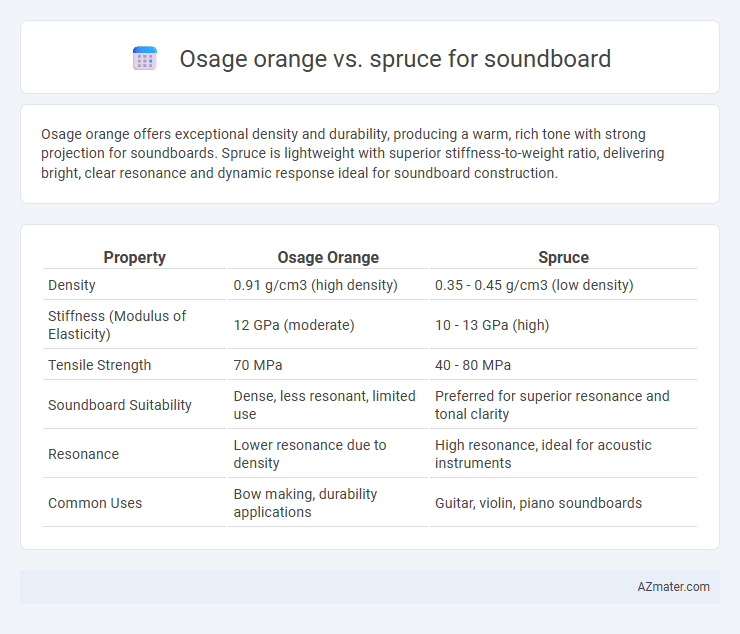Osage orange offers exceptional density and durability, producing a warm, rich tone with strong projection for soundboards. Spruce is lightweight with superior stiffness-to-weight ratio, delivering bright, clear resonance and dynamic response ideal for soundboard construction.
Table of Comparison
| Property | Osage Orange | Spruce |
|---|---|---|
| Density | 0.91 g/cm3 (high density) | 0.35 - 0.45 g/cm3 (low density) |
| Stiffness (Modulus of Elasticity) | 12 GPa (moderate) | 10 - 13 GPa (high) |
| Tensile Strength | 70 MPa | 40 - 80 MPa |
| Soundboard Suitability | Dense, less resonant, limited use | Preferred for superior resonance and tonal clarity |
| Resonance | Lower resonance due to density | High resonance, ideal for acoustic instruments |
| Common Uses | Bow making, durability applications | Guitar, violin, piano soundboards |
Introduction to Soundboard Materials
Osage orange and spruce are prominent choices for soundboard materials in stringed instruments, with spruce widely favored for its superior stiffness-to-weight ratio and resonant qualities that enhance sound projection and clarity. Osage orange, while less common, offers a dense, durable option known for its bright tonal characteristics and strong midrange response, making it suitable for certain specialized applications. Instrument makers prioritize the material's grain uniformity and acoustic properties to optimize vibration transmission and overall instrument tone.
Overview of Osage Orange Wood
Osage orange wood is known for its exceptional density, stability, and natural resistance to decay, making it a unique yet less conventional choice for soundboards compared to spruce. While spruce wood remains the industry standard due to its superior resonance and lightweight properties, Osage orange offers a distinct tonal character with increased durability and a bright, punchy sound profile. Its hard, fine-grained texture provides strong projection and sustain, but its heavier weight and stiffness may affect the traditional warmth and clarity found in spruce soundboards.
Overview of Spruce Wood
Spruce wood is a preferred material for soundboards due to its excellent strength-to-weight ratio, consistent grain, and superior resonance qualities, making it ideal for producing clear and vibrant sound in musical instruments such as guitars and violins. Unlike Osage orange, spruce offers greater stiffness and elasticity, which enhances sound projection and tonal clarity. Its uniform fibers and fine texture contribute to enhanced acoustic performance, establishing spruce as a top choice for professional soundboard construction.
Acoustic Properties: Osage Orange vs Spruce
Osage orange offers exceptional density and hardness, producing a bright, articulate sound with strong projection, making it ideal for soundboards requiring durability and clarity. Spruce, known for its lightweight and flexible grain, delivers superior resonance, warmth, and dynamic range, enhancing tonal richness and sustain in acoustic instruments. The acoustic properties of spruce prioritize responsiveness and harmonic complexity, while Osage orange emphasizes power and brightness, influencing soundboard performance based on desired tonal characteristics.
Tonal Characteristics Comparison
Osage orange offers a bright, clear tone with strong midrange presence and excellent sustain, making it ideal for sharp attacks and articulate soundboards in instruments. Spruce is renowned for its balanced tonal qualities, providing a warm, resonant sound with a broad dynamic range and smooth high-frequency response favored in acoustic guitar soundboards. The choice between Osage orange and spruce depends on the desired tonal emphasis--Osage orange for punchy clarity and spruce for rich, versatile warmth.
Durability and Longevity of Each Wood
Osage orange offers exceptional durability and resistance to decay, making it a highly reliable choice for soundboards subjected to varying humidity and temperature conditions. Spruce, while prized for its superior tonal qualities, is softer and more prone to wear and damage over time, requiring careful maintenance to ensure longevity. The dense, hard structure of Osage orange generally contributes to longer-lasting soundboards compared to the relatively delicate spruce wood.
Workability and Luthier Preferences
Osage orange offers excellent workability with its fine grain and moderate hardness, making it a favored choice among luthiers for intricate soundboard carving and shaping. Spruce, renowned for its lightweight and superior resonance, is preferred for producing bright, clear tones but requires more careful handling due to its softer, more brittle structure. Many luthiers prioritize spruce for its acoustical properties despite Osage orange's durability and ease of machining during the construction process.
Cost and Availability
Osage orange is significantly more expensive than spruce due to its rarity and limited commercial harvesting, making it less accessible for soundboard applications. Spruce, especially Sitka and Engelmann varieties, is widely available and cost-effective, ensuring consistent supply for musical instrument manufacturers. The lower cost and abundant availability of spruce make it the preferred choice for soundboards in guitars, violins, and other stringed instruments.
Suitability for Different Musical Instruments
Osage orange offers exceptional density and hardness, producing a bright, clear tone ideal for guitar and banjo soundboards requiring strong projection and sustain. Spruce is favored for its lightweight, resonant qualities, delivering a warm, balanced sound that suits violins, pianos, and classical guitars emphasizing dynamic responsiveness. The choice between Osage orange and spruce depends on the instrument's tonal requirements and desired acoustic characteristics.
Final Verdict: Choosing Between Osage Orange and Spruce
Osage orange offers exceptional density and durability, providing a bright, clear sound with excellent projection, making it ideal for robust and outdoor soundboards. Spruce, by contrast, is renowned for its lightweight structure, superior resonance, and balanced tonal qualities, preferred for precision and versatility in musical applications. Soundboard selection hinges on the desired tonal strength and playing environment, with Osage orange excelling in durability and projection, while spruce delivers superior acoustic clarity and dynamic range.

Infographic: Osage orange vs Spruce for Soundboard
 azmater.com
azmater.com